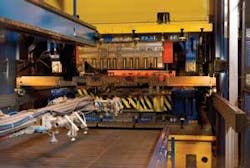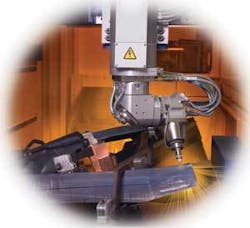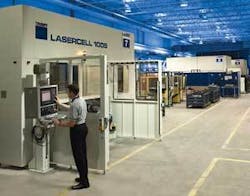Cutting steel for fuel-efficient cars
High tensile strength steel adds flexibility to car design
Ibrahim A. Libdeh, John Baysore, Holger Schlueter, and Michael Fritz
Today’s consumers are looking for fuel-efficient vehicles that provide maximum passenger safety. This can be a dilemma for a car manufacturer-improving the strength of the passenger compartment and crash test rating and simultaneously reducing the car’s weight to make it more fuel efficient.
In the past, some car producers have tried improving the stiffness of the passenger compartment by increasing the material thickness or adding additional material, basically integrating a roll-over bar into the structure. However, this approach adds weight and may reduce the fuel efficiency of an otherwise unchanged car.
Today, a whole range of new heat-treated steels provides a way out of this dilemma. By heating the steel before the forming process and then rapidly cooling it down in the forming tool, the microstructure of the steel can be changed and the stiffness-more accurately the tensile strength-can be greatly improved and actually customized for different needs.
Of particular interest are the hot formed boron steels. The hot forming process can form a variety of complex parts and hold relatively tight tolerances. Conversely, forming of traditional ultra-high strength steels significantly limits part complexity and tolerances achieved due to spring back conditions. The hot formed parts can achieve a tensile strength above 1300MPa. Parts made from boron steels get their strength from the rapid cool down, which “freezes” the microstructure of the alloy and therefore creates a martensitic material structure. It can be used for structural components of a car.
It is projected that the use of hot formed steels in car manufacturing will increase significantly in the coming years. An entirely new process chain in the press shop needs to be established.
Supplying a solution
Several car manufacturers and original equipment manufacturer (OEM) suppliers like ThyssenKrupp Fabco in Detroit, already produce an entire range of parts made from hot formed boron steels.
In order to manufacture parts from boron steel, ThyssenKrupp Fabco invested in equipment to heat the blanks to a temperature of 950°C and a press that could cool down the hot parts in a time suitable for their production schedule. The furnace and the press are co-located and the hot blank is automatically loaded into the press (see Figure 1). The part is stamped while still hot and then rapidly cooled down using a water-cooled die (see Figure 2).
After the hot forming process, the part needs to be trimmed and in some cases cut outs are required. Normally, the trimming and the cut outs could be produced using a mechanical cutting and piercing process. For the hot stamped steels, this leads to high tool wear, and the mechanical cutting process doesn’t allow for easy changes in terms of part trim lines and moving or changing sizes of holes. Therefore, manufacturers of hot formed steel parts use CO2 laser-based five-axis laser cutting centers to trim the edges and provide the cut outs.
Five-axis laser centers (see Figures 3 and 4) provide the accuracy needed for the trimming operation. Required part accuracy ranges from - 0mm /+ 3mm in areas where the parts are not joined, and down to ±0.4mm in areas where the parts have to be joined or where tolerances are critical for the overall dimensions of the car body. Because the beam guidance is attached to a rigid frame, path accuracy on the order of +/-0.1mm can be achieved in a production environment at high dynamics of all axes without influence to the path geometry.
It is a concern that robot-based cutting systems cannot provide the rigidity and path accuracy required in this application over an extended period of time. They also do not provide the high acceleration of five-axis laser systems and are therefore limited in productivity. With this five-axis laser cutting center, the exhaust system is tailored to the cutting operation for operator safety, machine reliability and extended life of components. The built-in laser ensures operator safety and there is a communication interface for line control and fixture control. The work envelope is adequate for various part sizes and expandable for new part geometry.
The preferred cutting process for hot stamped steels is high-pressure nitrogen cutting with pressures ranging from 200 to 300 PSI to ensure the highest possible cut quality. The cutting speeds range from 30 IPM in tight areas and cutting under normal angles of 30° to 50° to 720 IPM on large contours. The laser power ranges from 500 watts at slow speeds to >3 kW in open contour areas. Therefore, the recommended laser power is 3 kW or above. Figure 5 shows a part made from hot stamped steel before and after cutting. The part has been trimmed, separated into two, and additional holes have been added using the laser cutting process. The laser source of choice for laser cutting in this three-dimensional application is an RF-excited, fast-axial-flow CO2 laser that provides power up to 6000 watts with a beam quality of from 3 to 6 mm mrad.
Summary
Car body parts made from hot formed steel enable new, fuel-efficient vehicles with improved stiffness and passive passenger safety. These parts are manufactured in a novel process that requires the forming of a 1700°F hot blank. Laser cutting with highly reliable and productive CO2 lasers provides the solution for flexible part trimming. The integration of the laser in high acceleration five-axis laser cutting centers allows the productivity and path accuracy that is required by the OEMs and their suppliers.
The process has been implemented by car manufacturers in volume production. Progressive suppliers like ThyssenKrupp Fabco, one of the few companies investing in the high-volume production of hot formed stampings in North America, provides these parts to their OEM customers. This enables the use of these exciting new materials even on car models where the investment in a whole new press shop might not seem economically viable for the car manufacturer.
Ibrahim A. Libdeh and John Baysore are with ThyssenKrupp Fabco and Dr. Holger Schluetter and Michael Fritz are with TRUMPF Inc. (www.us.trumpf.com).





